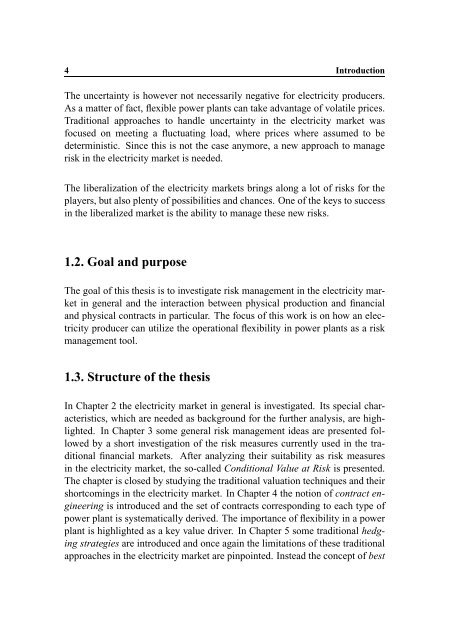Hedging Strategy and Electricity Contract Engineering - IFOR
Hedging Strategy and Electricity Contract Engineering - IFOR
Hedging Strategy and Electricity Contract Engineering - IFOR
Create successful ePaper yourself
Turn your PDF publications into a flip-book with our unique Google optimized e-Paper software.
4 Introduction<br />
The uncertainty is however not necessarily negative for electricity producers.<br />
As a matter of fact, flexible power plants can take advantage of volatile prices.<br />
Traditional approaches to h<strong>and</strong>le uncertainty in the electricity market was<br />
focused on meeting a fluctuating load, where prices where assumed to be<br />
deterministic. Since this is not the case anymore, a new approach to manage<br />
risk in the electricity market is needed.<br />
The liberalization of the electricity markets brings along a lot of risks for the<br />
players, but also plenty of possibilities <strong>and</strong> chances. One of the keys to success<br />
in the liberalized market is the ability to manage these new risks.<br />
1.2. Goal <strong>and</strong> purpose<br />
The goal of this thesis is to investigate risk management in the electricity market<br />
in general <strong>and</strong> the interaction between physical production <strong>and</strong> financial<br />
<strong>and</strong> physical contracts in particular. The focus of this work is on how an electricity<br />
producer can utilize the operational flexibility in power plants as a risk<br />
management tool.<br />
1.3. Structure of the thesis<br />
In Chapter 2 the electricity market in general is investigated. Its special characteristics,<br />
which are needed as background for the further analysis, are highlighted.<br />
In Chapter 3 some general risk management ideas are presented followed<br />
by a short investigation of the risk measures currently used in the traditional<br />
financial markets. After analyzing their suitability as risk measures<br />
in the electricity market, the so-called Conditional Value at Risk is presented.<br />
The chapter is closed by studying the traditional valuation techniques <strong>and</strong> their<br />
shortcomings in the electricity market. In Chapter 4 the notion of contract engineering<br />
is introduced <strong>and</strong> the set of contracts corresponding to each type of<br />
power plant is systematically derived. The importance of flexibility in a power<br />
plant is highlighted as a key value driver. In Chapter 5 some traditional hedging<br />
strategies are introduced <strong>and</strong> once again the limitations of these traditional<br />
approaches in the electricity market are pinpointed. Instead the concept of best
















